
Eat Your: Chicken
When committing to a fitness style diet plan, one of the first things you may be told is to start eating chicken. The baked-chicken-for-dinner-every-night stereotype
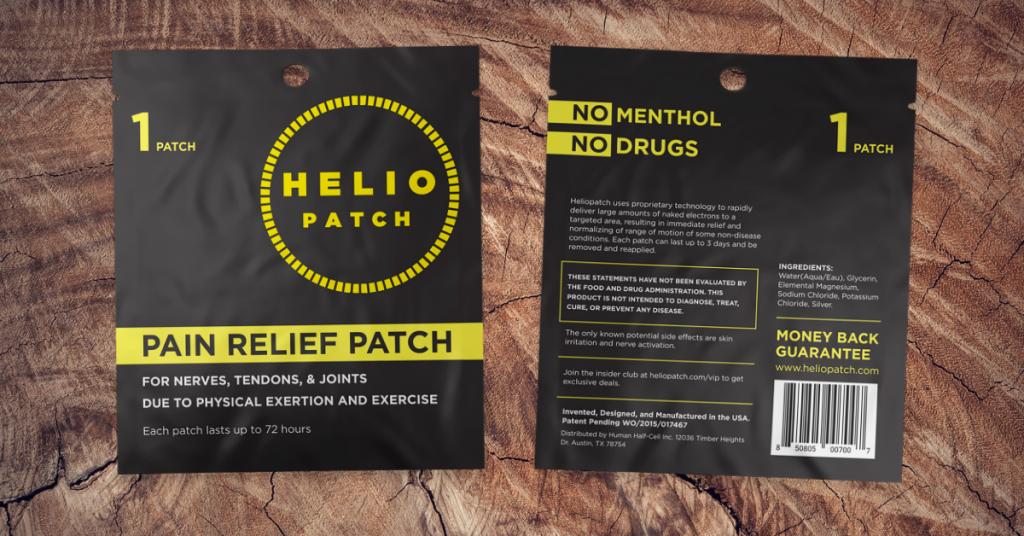

Introduction
Heliopatch is based on patent pending Human Half-Cell Technology. Human Half-Cell Technology allows the human body to function as one-half of a battery – the cathode. Our patch technology provides the anode that completes the battery. Other electrical products that interact with the human body, such as TENS, tazers or iontophoresis, operate by different mechanism; these methods have always used the body as the resistor or wire.
 For an illustration of past technologies, the image to the left shows a simple circuit with a load – a battery illuminating a light bulb. For a battery to work properly, a molecule needs to act as an electron donor- a reducing agent. In the example above, this is the black anode, which is shown as negative because of the abundance of negatively charged electrons it provides.
For an illustration of past technologies, the image to the left shows a simple circuit with a load – a battery illuminating a light bulb. For a battery to work properly, a molecule needs to act as an electron donor- a reducing agent. In the example above, this is the black anode, which is shown as negative because of the abundance of negatively charged electrons it provides.
To achieve electron flow, the anode needs to be connected to a cathode in two ways. It must be electrically connected via a conductor to allow transfer of electrons and ionically connected via an electrolyte allowing ions to move. In this illustration the cathode is orange and anode is black. Ions move through the electrolyte to balance charge while electrons travel down the conductor to complete the redox (reduction/oxidation) reactions. The electrons in the anode are driven to the cathode because of the voltage difference in the reactants. The electrons follow the path of least resistance – the wire.
Very few electrons travel through the electrolyte, but ions move freely. As the electrons flow through the wire, they create heat in the light bulb along the way, losing voltage until they get to the other side, which is the cathode. Enough voltage has to remain to allow the spontaneous reaction, if the load provides too much resistance, then no electrochemical reactions can occur.
The cathode is an oxidizing agent, which means its outer shell can gain electrons. When it gains electrons, its net charge becomes more negative. In order to maintain a balance between the two halves of the battery, ions need to shuttle between the anode and cathode to keep the electrons flowing. The cathode gives up negative ions (anions) to the anode, these are the red minus symbols , while the anode gives up positive ions (cations), the blue positive symbol. Anions and cations are transferred between the cathode and anode travelling through the electrolyte as the medium. The electrolyte (or salt bridge) is a fluid or solid that allows the flow of ions, but very few electrons. This exchange of electrons from the anode to the cathode through the wire and ions between the cathode and anode through the electrolyte allows a continuous flow of electrons and keeps the charges in balance.
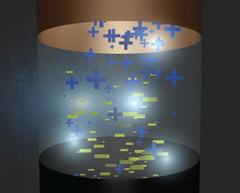 These principles have all been thoroughly studied within the field of electrochemistry, but their application has been limited. The reactions within a battery have not been conceptually transferred to interactions between an organism and an anode, treating the organism as half of the battery. In our system, the parts of the diagram are the same as the illustration above, but the cathode (orange) is replaced by a person. There is no need for an electrically resistive electrolyte; we have the option of allowing electrons and ions to transfer along the same path.
These principles have all been thoroughly studied within the field of electrochemistry, but their application has been limited. The reactions within a battery have not been conceptually transferred to interactions between an organism and an anode, treating the organism as half of the battery. In our system, the parts of the diagram are the same as the illustration above, but the cathode (orange) is replaced by a person. There is no need for an electrically resistive electrolyte; we have the option of allowing electrons and ions to transfer along the same path.
How Heliopatch Works
The human body is subject to oxidative stress at the cellular level. Normal cellular function is not perfectly efficient. Mitochondria (the power plants of the cell) generate energy, but like real power plants, they also generate pollution. These pollutants are known as free radicals. Free radicals strip electrons from surrounding structures and impede normal cell function. Free radicals are combated by antioxidants -reducing agents that donate electrons to free radicals, neutralizing their destructive character. Ideally, our bodies can manufacture on its own or absorb enough antioxidants from a nutritious diet to counter much of the threat of free radicals, but in many circumstances, natural antioxidants can be depleted. Poor diet can limit their supply and increased oxidative stress occurs during high intensity exercise when your body is not getting enough oxygen or if you are under immune system attack.
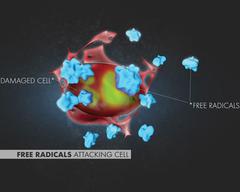 This leakage of free radicals causes oxidative stress because these free radicals “steal” an electron from a more reducing molecule which then takes an electron from another molecule, which takes from the next, causing a free radical chain reaction. The mitochondrial leakage is intensified from strenuous exercise as the body is pushed to its limit to produce more energy.
This leakage of free radicals causes oxidative stress because these free radicals “steal” an electron from a more reducing molecule which then takes an electron from another molecule, which takes from the next, causing a free radical chain reaction. The mitochondrial leakage is intensified from strenuous exercise as the body is pushed to its limit to produce more energy.
Antioxidants stop this chain reaction by freely donating an electron without having to steal one from somewhere else. Human Half-Cell Technology does the same thing by donating naked electrons to the body. We have eliminated the need for the molecular middleman of the antioxidant molecule and can just deliver the pure, naked electrons, to any location on or in the body and in quantities that far exceed what any molecular antioxidant can match. The naked electrons delivered by Heliopatch are unique in that they leave zero waste. Once they’ve neutralized a free radical, the remaining molecule is benign and chemically neutral often becoming hydroxide (OH–) or water (H2O). These electrons are now part of the new molecule. Because Heliopatch changes the molecular structure of a hydroxyl (•OH) free radical to hydroxide (OH–), it actually creates an alkaline environment in the target area, which is a benefit whenever your body is under stress and producing lactic acid.
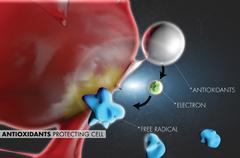
Other Sources of Free Radical Damage
Another source of free radical damage comes from our body’s own immune system; it uses free radicals as a weapon against invaders such as bacteria or viruses. In the same way that free radicals disrupt cell function by stealing electrons, they also impede the function of malignant agents, causing invaders to break down and malfunction. Usually, the immune system functions properly, but sometimes it picks the wrong target and starts attacking its own cells. This is called autoimmunity and is the cause of arthritis, psoriasis, dermatitis and many other harmful conditions. It is important to use Heliopatch only on healthy people without any fever or other indication of infection. It is essential that the cause of pain is known and not the result of an infection, where the action of the immune system is a productive, valuable response. Other oxidizing conditions like sunburn are caused by ionizing radiation from the sun, which causes oxidation in our skin cells. This is why mountain climbers will often get sunburned even though it is very cold where they are – it is not a heat issue, instead this is a result of the sun’s powerful radiation. Other sources of radiation in the environment are radioactive elements which produce radiation and particles which cause cellular damage. Some sources of environmental radiation damage are elements such as inhaled radon or ingested polonium.
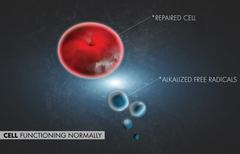
Dietary Antioxidants
Our diets should give us adequate antioxidants, but food processing and storage has systematically depleted these from most people. At the same time, the oxidative load of free radicals from outside sources, like pollution, has greatly increased our oxidative burden. These antioxidants from outside sources help manufacture our internally usable co-factor antioxidants, such as glutathione. Dietary antioxidants obtained from foods like blueberries are mostly depleted in the gastrointestinal tract. Furthermore, the lion’s share is taken by the liver and the remainder is diluted throughout the body. Since dietary antioxidants must pass through your digestive tract, they can do little for inflammation in one specific part of the body – no matter how many blueberries you eat; it is probably going to do little for the tendinitis in your elbow. Dietary antioxidants have another distinct drawback – you have to eat them, and this means consuming expensive supplements or large quantities of unfamiliar, unpalatable food. High antioxidant “superfoods” are often expensive and increase your caloric intake. Those calories have to be burnt by mitochondria, and their burning comes with more free radicals as a consequence. The combined difficulties of balancing oxidative stress, dietary antioxidant intake and caloric intake make managing free radicals via diet very difficult. To consume enough antioxidants during a sporting or fitness event to offset all of your oxidative stress would lead to full stomach issues which might counter any benefit from the supplementation. Another big problem with molecular antioxidants is that after they donate their electron they no longer serve any worthwhile purpose and are essentially a waste product that needs to be gotten rid of by the body. A major advantage of Human Half-Cell Technology is that our naked electron is wholly consumed by the oxidizing molecule, leaving zero waste.
Inflammation
Inflammation is caused by the body’s response to unwanted stimuli, such as a pathogen or damaged cells. The immune system attacks an area of the body, either rightly or wrongly. Everyone is familiar with inflammation and the pain it causes; if an over the counter pain reliever like Tylenol solves the pain, it was caused by inflammation. If a steroid resolves pain, then the inflammation was caused by an immune response. Autoimmune diseases are problems that arise when the immune system attacks the body’s own cells. Some examples of autoimmune diseases are rheumatoid arthritis, psoriasis, Crohn’s disease, lupus, Hashimoto’s and many more. Current treatment for autoimmune disorders typically involves suppressing the body’s overall immune function, which makes the sufferers more susceptible to infections and pathogens. A simple cut or a sick child can be dangerous for an immune suppressed individual. Human Half-Cell Technology’s area of effect is strongest in the immediate area of application and is reversible simply by removal from the skin. Compare this to an injection of cortisone, which has a long effect and has no opportunity for reversal when an infection occurs. The same goes for pain relief and management. Why treat a whole person’s body and mind with large quantities of a drug if the pain is just in one part of the body?
 Versatile Pain ReliefThere are other circumstances, such as head trauma (concussions), where a trauma leads to a cascade effect of inflammation and oxidative stress events. It has been shown the antioxidant glutathione can help prevent a significant amount of brain damage in concussed mice. When researchers applied glutathione three hours after injury, cell death was reduced by 51 percent. Glutathione works by decreasing levels of reactive oxygen species (ROS) molecules that damage cells. In this study, high levels of ROS were observed at the trauma site right after the physical brain injury occurred. The massive flood of ROS set up a sequence of events that led to cell death in the brain, but glutathione was able to prevent many of those effects. However, this chemical is not easily administered to humans in this way, due to our thicker skulls and more complex blood brain barrier.
Versatile Pain ReliefThere are other circumstances, such as head trauma (concussions), where a trauma leads to a cascade effect of inflammation and oxidative stress events. It has been shown the antioxidant glutathione can help prevent a significant amount of brain damage in concussed mice. When researchers applied glutathione three hours after injury, cell death was reduced by 51 percent. Glutathione works by decreasing levels of reactive oxygen species (ROS) molecules that damage cells. In this study, high levels of ROS were observed at the trauma site right after the physical brain injury occurred. The massive flood of ROS set up a sequence of events that led to cell death in the brain, but glutathione was able to prevent many of those effects. However, this chemical is not easily administered to humans in this way, due to our thicker skulls and more complex blood brain barrier.
With Human Half-Cell Technology, this should not be a problem for the much smaller electron. Unlike an injection, electrons can easily penetrate the human skull and blood brain barrier.
In addition to significantly and quickly reducing general pain, Human Half- Cell technology has also helped speed healing from a variety of ill effects. The effects range from immediately stopping itchy hives, to relieving pain and cramps associated with PMS. Further, we have witnessed support of natural wound healing process, similar to how low intensity direct current has been shown to accelerate wound healing.
Now for the How
We understand that the human body is receptive to naked electrons and that these electrons have a reducing effect on cells. The question then becomes – how do we easily donate those naked electrons to the body and create a voltaic cell?
Reactive Elements
Certain elements are electron donors, such as those found in the two left columns of the periodic table – alkali metals and alkali earth metals. These include sodium, potassium, calcium and magnesium. The alkali metals have one electron to donate and the alkali earth metals have two electrons to donate. There are a few problems to overcome; one is how to get those electrons out of these metals and into the user in a useful way, and another is choosing which element will be the most safe and effective for electron donation. Regarding the element choices, it isn’t feasible to use the group 1 elements such as sodium or potassium as they are too reactive, generating hydrogen and heat when in contact with water which leads to fire; so they are out of the question. The group 2 elements such as calcium and magnesium are better. They are more energy dense, as they have two electrons to donate per atom. These elements are less reactive because of a passivating insoluble salt or hydroxide coating on the outside that slows further reactions. This passivation makes it difficult to continuously extract electrons. One way we can solve the issue of passivation is via abrasion (scratching, brushing) or to include some acidity in the electrolyte that helps strip away these insoluble coatings. Because these ions may travel into the body, it is important to select an element that is not only safe, but also nutritious if consumed by humans. Finally, it is important to consider the element’s place in the table of standard reducing potentials to provide the highest voltage and therefore the deepest penetration of electrons into the body.
Standard Reducing Potentials
This table shows the voltage an element or compound is capable of providing when it gives up electrons to a cathode. You can see magnesium is one of the most charged elements; right above it is lithium which is used in high performance batteries for phones and vehicles.
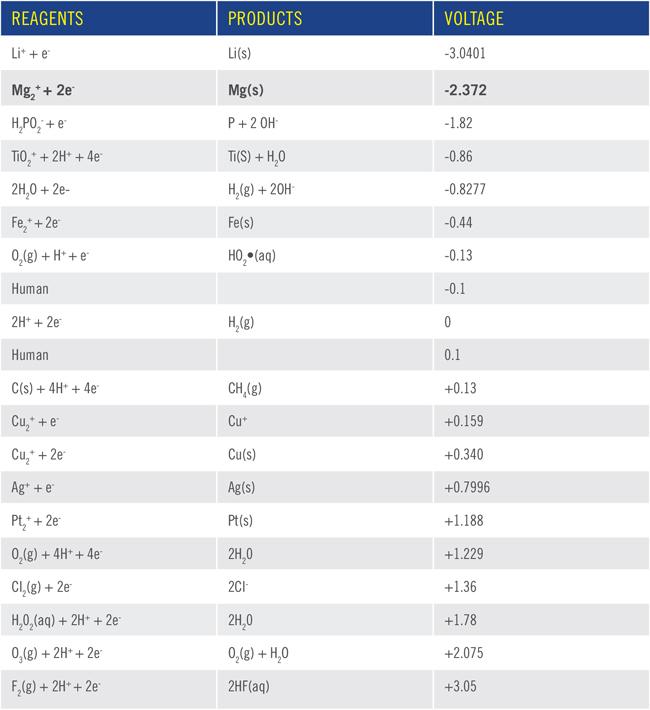
The Benefits of Magnesium
Elemental magnesium satisfies all of our requirements – it is stable, energy dense and nutritious for humans. Magnesium is usually acquired from consumption of leafy green vegetables, which means that many people don’t receive enough of this important nutrient.
By administering magnesium transdermally, Heliopatch can help to remedy a pervasive nutritional deficiency. Magnesium has been found to be positively associated with skeletal muscle power. It has also been used for therapeutic purposes for women suffering from PMS and painful menstrual cramps. It should be noted that dietary magnesium is the already oxidized magnesium that has given up its two electrons to become the ion Mg2+. Elemental magnesium is different in that it still has its electrons to donate, but once it does, it becomes an ion, Mg2+.
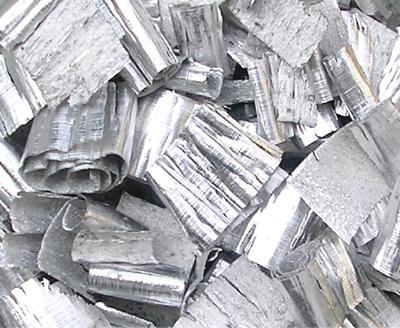
Unlocking Magnesium’s Potential
Magnesium forms an oxide coating around it when exposed to air, this can be removed by either abrasion or using a highly soluble acid. However, once the fresh metallic surface is exposed, it will be immediately attacked by atmospheric oxygen and will be oxidized again. One way to circumvent this is by using our all natural trade secret compound on the exposed raw magnesium. This addition allows the electrons to flow out of the magnesium continuously. By contrast, if you just had pure unoxidized magnesium and touched it with bare skin the corrosion layer would quickly impair the flow of electrons and the voltage would diminish rapidly.
Choosing the Electrolyte
Now that we have an electron donor (Mg) and a path out for the electrons, we need a good way for the ions to transfer – we need an electrolyte. To quickly review, here are the three things we need to form a Human Half-Cell.
Anode = Magnesium
Cathode = Reactive oxygen species (free radicals) in the body.
Electrolyte = Salty solution to allow flow of ions between the anode and cathode, and keep their charges neutral to each other.
The flow of the ions is the second major hurdle to creating a functioning half-cell out of a human. An electrolyte is required as the positive ions flowing from it will enter the body to counteract the negative charge of the electron and keep the person’s charge neutral – allowing more and more electrons to enter.
Our Electrolyte Blend and the Potential of Electrolytes
The electrolyte formulation provides us with another opportunity to provide our choice of ions to the user. Our standard electrolyte solution is an isotonic solution of sodium chloride, potassium chloride, water and glycerin. The sodium chloride and potassium chloride are the electrolytes with the water, while the glycerin keeps the skin hydrated and lubricated.
We have also been experimenting with a magnesium, calcium, strontium and glucosamine/chondroitin blend for providing nutrients to bones and ligaments. By experimenting with different blends of positively charged molecules we can provide different nutritional benefits to users. This system allows ions to be delivered directly to the site where the nutrient activity is desired as opposed to diluting them through your whole system. This can also avoid sending nutrients to parts of the body where they have undesired effects, such as the laxative effects of magnesium when consumed orally.
It is important to note that this method and tech works differently from iontophoresis. First, we are using the person as one half the electrochemical cell instead of just the conduit for ions and electrons like iontophoresis. Secondly by using a reducing environment with an abundance of free electrons to prevent oxidation we can deliver oxidatively delicate positively charged molecules and ions. This means we are able to keep them intact and consistent, as opposed to the oxidative effects under the positive electrode that iontophoresis elicits.
The Heliopatch
With all elements of the voltaic cell accounted for, we need a way to easily and inexpensively apply Human Half-Cell Technology to the human body. After a few years of research and development, we developed Heliopatch. Heliopatch is a transdermal, water-resistant patch that contains the magnesium anode and electrolyte solution. Heliopatch can be directly applied to areas of discomfort to deliver naked electron therapy.
Improving Ion Flow
The outermost layer of skin is dead and non-conductive, which impedes ion transfer from the Heliopatch. We have tried using an abrasive alcohol pad but this had little impact on its own. However when we apply a saline/glycerin solution to the skin it hydrates and after several minutes allows a much greater rate of ion transfer to happen. This lets even more electrons enter the user. The combination of Heliopatch and the Activator solution as a mixed conductor leads to hours of relief.
Human Half-Cell in the Future
Oxidation of cells is both good and bad. It can be beneficial, as it can eliminate malfunctioning cells before they cause problems. Uncontrolled oxidation is a major factor in aging. We believe with our controlled delivery of pure antioxidants we can benefit cell growth and health – particularly as we develop other technologies and therapies to form an overall method of treatment. We believe that our approach can be a cornerstone in future life extension therapies to help people live well beyond the current expectancy. Our goal is to have a fully functioning life extension pod for use by the year 2020, using our technologies with others, to form a full, comprehensive treatment.

When committing to a fitness style diet plan, one of the first things you may be told is to start eating chicken. The baked-chicken-for-dinner-every-night stereotype

Every athlete has their idols. The person they saw on TV as a kid and thought, “That’s who I want to be.” For

